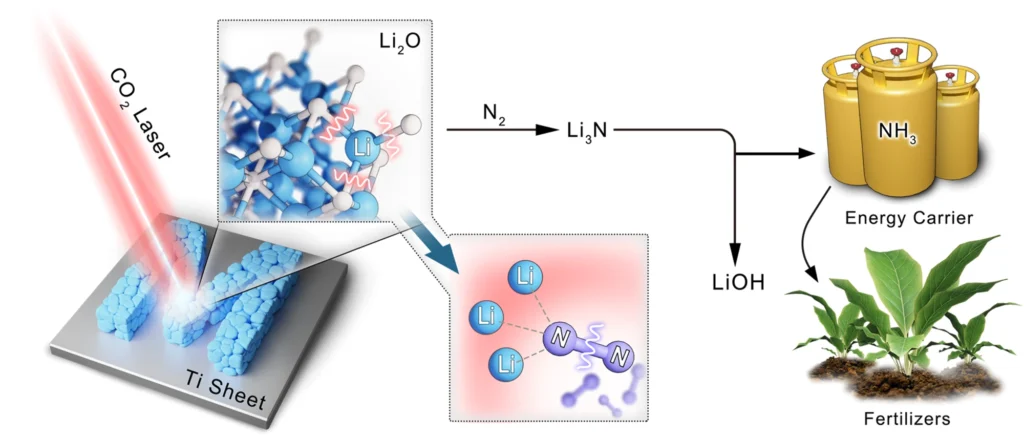A Century of Reforestation Helped Keep the Eastern U.S. Cool
Widespread 20th-century reforestation in the eastern United States helped counter rising temperatures due to climate change, according to new research published in the journal Earth’s Future. The authors highlight the potential of forests as regional climate adaptation tools, which are needed along with a decrease in carbon emissions.
“It’s all about figuring out how much forests can cool down our environment and the extent of the effect,” said Mallory Barnes, lead author of the study and an environmental scientist at Indiana University. “This knowledge is key not only for large-scale reforestation projections aimed at climate mitigation, but also for initiatives like urban tree planting.”
From the late 18th to early 20th centuries, timber harvests and clearing for agriculture led to forest losses of more than 90 percent in some areas. In the 1930s, efforts to revive the forests, coupled with the abandonment and subsequent reforestation of subpar agricultural fields, kicked off an almost century-long comeback for eastern forests. About 15 million hectares of forest have since grown in these areas.
During the period of regrowth, global warming was well underway, with temperatures across North America rising 0.7 degrees Celsius (1.23 degrees Fahrenheit) on average. In contrast, from 1900 to 2000, the East Coast and Southeast cooled by about 0.3 degrees Celsius (0.5 degrees Fahrenheit), with the strongest cooling in the southeast.
Previous studies suggested the cooling could be caused by aerosols, agricultural activity or increased precipitation, but many of these factors would only explain highly localized cooling. Despite known relationships between forests and cooling, studies had not considered forests as a possible explanation for the anomalous, widespread cooling.
“This widespread history of reforestation, a huge shift in land cover, hasn’t been widely studied for how it could’ve contributed to the anomalous lack of warming in the eastern U.S., which climate scientists call a ‘warming hole,’” Barnes said.
The team used a combination of data from satellites and 58 meteorological towers to compare forests to nearby grasslands and croplands, allowing an examination of how changes in forest cover can influence ground surface temperatures and in the few meters of air right above the surface.
The researchers found that forests in the eastern U.S. today cool the land’s surface by 1 to 2 degrees Celsius (1.8 to 3.6 degrees Fahrenheit) annually. The strongest cooling effect occurs at midday in the summer, when trees lower temperatures by 2 to 5 degrees Celsius (3.6 to 9 degrees Fahrenheit) — providing relief when it’s needed most.
Using data from a network of gas-measuring towers, the team showed that this cooling effect also extends to the air, with forests lowering the near-surface air temperature by up to 1 degree Celsius (1.8 degrees Fahrenheit) during midday. Previous work on trees’ cooling effect has focused on land, not air, temperatures.
The team then used historic land cover and daily weather data from 398 weather stations to track the relationship between forest cover and land and near-surface air temperatures from 1900 to 2010. They found that by the end of the 20th century, weather stations surrounded by forests were up to 1 degree Celsius (1.8 degrees Fahrenheit) cooler than locations that did not undergo reforestation. Spots up to 300 meters (984 feet) away were also cooled, suggesting the cooling effect of reforestation could have extended even to unforested parts of the landscape.
Other factors, such as changes in agricultural irrigation, may have also had a cooling effect on the study region. The reforestation of the eastern United States in the 20th century likely contributed to, but cannot fully explain, the cooling anomaly, the authors said.
Insects Protect Apples When Flowers Planted on Farms
Bugs including hoverflies, lacewings and ladybirds play an important role in keeping Britain’s apples healthy, a new study has shown.
Wildflower strips planted around apple orchards provide a habitat for predatory insects that prey on pests that deform and damage apples.
Flower margins had been established next to five dessert apple orchards in the U.K. A research team led by the University of Reading found that only 48 percent of trees had fruit damage, compared to 80 percent in orchards without flowers.
The two-year study published in the Journal of Applied Ecology suggests farmers could harvest up to an additional 2,420 kg per hectare (6.9 percent) of undamaged, premium apples by installing flower margins on orchards.
The study used large, mature wildflower margins more than five meters wide and included grasses and flowers chosen to supply year-round food sources. The long-established nature of the margins gave time for diverse communities of predatory insects to build up.
The research team found that flower margins reduced not only the spread of aphids on trees, but also how many fruits were attacked on infested trees. Apples near flower borders had more than a third less chance of fruit damage even during peak aphid outbreaks. Significant reductions in damaged crop extended up to 50 meters into orchards from the floral habitat.
Simple conservation measures like dedicating orchard edge habitat for wildflowers could reduce reliance on pesticide sprays over the long term.
A New Method for Producing Ammonia Ammonia (Courtesy of Nature Communications) While ammonium is generally a preferable form of nitrogen for growers compared to ammonia or nitrate, a group of researchers has developed a new way to produce ammonia directly from atmospheric nitrogen that is much less energy intensive than the existing Haber-Bosch process. The method uses simple CO2 lasers to dissociate lithium oxide powder into metallic lithium; this reacts with atmospheric nitrogen to produce lithium nitride, which is easily converted into liquid ammonia (NH3). These reactions can all occur at room temperature and pressure and do not produce carbon emissions. |
Asexual Propagation of Crop Plants Gets Closer

Farmers often use hybrid varieties of seeds, which are created by crossing two inbred lines and are more resistant and higher yielding than normal varieties. The problem is that these desired properties are lost during propagation; hybrid seeds have to be recreated every year.
If we could find a way to propagate crop plants by asexual reproduction through seeds — a process known as apomixis — it would revolutionize agriculture. If it were possible to bypass the reductional division and fertilization of female gametes, the seeds produced would be genetically identical to the mother plant. Plant varieties with desired characteristics could thus be propagated much more easily — as seed clones.
A University of Zurich team has come a step closer to achieving this goal. “In the model plant thale cress we have discovered the signal that activates the female gamete to form a new seed,” said team leader Uli Grossniklaus.
The fertilization process in plants consists of two events. Two sperm cells merge with one female gamete each — one sperm cell fertilizes the egg, from which the embryo and ultimately the next generation is formed, while the other one fuses with the central cell, which develops into a placenta-like tissue that supplies the embryo with nutrients. Together, they develop into mature seeds. For fertilization to be successful, sperm cells and female gametes must be in the same phase of the cell cycle — in other words, they need to be “in sync” with each other.
The targeted activation of cell division without fertilization opens up new possibilities for introducing apomixis into crop plants, especially in the more resilient and higher-yielding hybrid varieties.
Scientists already knew that the sperm cells in thale cress (Arabidopsis thaliana) are in the preparatory phase for cell division. The research team has now shown that the quiescent egg cell is also in this phase. The central cell, on the other hand, remains stuck in the middle of the preceding phase, in which the genetic material gets duplicated. While sperm and egg cells are in the same cell cycle phase, the central cell must first complete DNA synthesis after fertilization before the first division can begin.
This interruption in the cell cycle is caused by a protein in the central cell that is not completely degraded and is thus still present. When the sperm fertilizes this gamete, it introduces the protein cyclin, which then activates the decomposition of the inhibitory protein. Only then can the central cell complete DNA synthesis and move into the next phase of the cell cycle. “For the first time, we have managed to figure out the molecular mechanism of how the signal is delivered from the sperm to the female gamete in order to shift it out of its quiescent state. It signals to the central cell that fertilization was successful and that cell division can now take place,” said first author Sara Simonini.
If thale cress were to be genetically modified such that the central cells produced the protein cyclin themselves, they would begin to divide even without fertilization. “We can now deliberately trigger this activation in the absence of fertilization. This opens up opportunities to introduce apomixis in crop plants, in particular in hybrid varieties that are more resilient and produce higher yields than normal varieties,” said Grossniklaus. If apoximis could be harnessed in crop plants, millions of small-scale farmers would for the first time be able to grow hybrid varieties whose seeds could be saved for the next sowing.
 Dr. Robert Kremer, 1950-2024We are saddened to acknowledge the passing of Dr. Robert Kremer, a frequent contributor to this magazine over the past few years and a speaker at our 2016 conference.Dr. Kremer earned a Ph.D. in microbiology from Mississippi State University and worked at the USDA Agricultural Research Service for 35 years. In “retirement” he assisted many farmers through his KC Consulting company.Dr. Timothy Reinbott, director of the Sanborn Field research center at the University of Missouri, said, “I considered Bob a great friend and mentor, and someone that I admired. We have so many projects that we were working on in regenerative agriculture and soil health (they are intertwined); I don’t know who is going to fill his shoes.”  Bob Moore, 1929-2024Bob Moore, founder of Bob’s Red Mill and one of the most recognized figures in the natural foods industry, peacefully passed away at home on February 10, at the age of 94. Moore will be remembered for his larger-than-life personality, his leadership and passion for whole grains, his strong work ethic (he remained a Board Member of his beloved Bob’s Red Mill until his death) and his generosity in establishing the Employee Stock Ownership Plan (ESOP) on his 81st birthday. Read Robert Kremer’s article, “Do We Understand the Consequences?” as well as our 2013 interview with Bob Moore at https://members.acresusa.com. |















